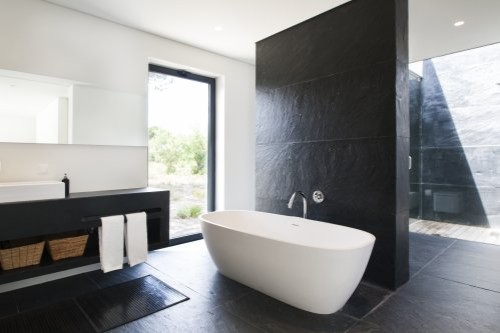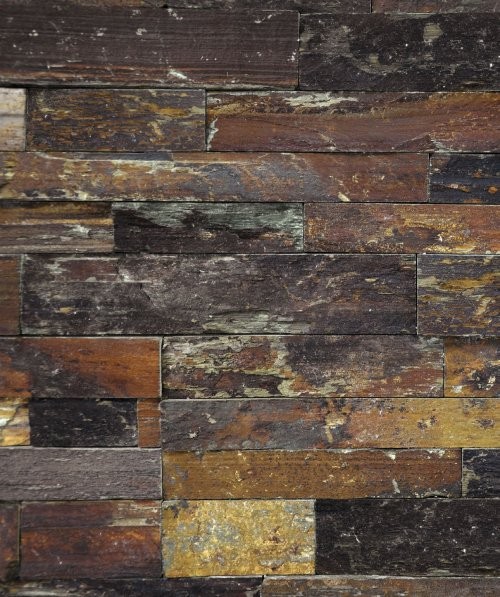Hardly anyone can resist the temptation to let their palm feel the unique feel of slate. The apparent contradiction of rock hardness, warmth and soft velvet surface has always fascinated. Discover a surprising variety of slate variants and delightful possibilities. Get natural unique pieces everywhere in and around the house.
More about slate, its advantages and its history...
Wir können aus unserem gesamten Produktsortiment Wandriemchen und Mosaike nach individuellen Vorgaben fertigen.
Im Folgenden eine Auswahl unserer standardisierten, lagernden Produkte.
Table of Contents
- Natural stone slate: folded fine stone
- Durable slate, as if made for everyday life
- Slate variety from all over the world
- Slate: adaptable and highly topical ...
- The advantages of slate at a glance:
- Small excursus in geology and history of slate
- Red, green, violet, light grey and colourful: a kaleidoscope of colours
- Old slate art on roof and wall
- How to find your way around easily
- Any further questions?
Natural stone slate: folded fine stone
Every layman recognizes "classic" (clay) slate almost immediately: a predominantly dark-colored natural stone with a comparatively soft, velvety uneven surface in the characteristic wafer-thin gradations. Formed by splitting very fine-grained blocks of rock along the almost parallel schistosity. This in turn is the result of various geological processes over millions of years. Starting point was the sedimentation of clay and other organic and mineral components. This was followed by variously pronounced, enormous folding processes of the earth's crust, which, due to directed pressure and enormous heat effects, led to mineral transformation (metamorphosis). Would you like to learn more about the geology and history of slate? A bit further down we give a small insight.
Durable slate, as if made for everyday life
Despite its fragile, fine-leaved structure, slate is extremely resistant - at least measured in human ages. It is not for nothing that for centuries it was a substitute for several generations for fire-prone roofing made of straw or wood in harsh low mountain climates. Initially reserved for the upper classes and the clergy, from the 19th century onwards it also shaped entire villages.
Slate stores and conducts heat extremely well, which is why it cools in summer and warms up quickly in the winter sun. This natural stone looks most natural in its untreated state, just as the irregularly thick slabs come from the "Spaltütte".
Whether window sills, washbasin or worktop: many fascinating options open up, because natural stone slate is an extremely versatile and formative companion, which, as an easy-care everyday companion, does not immediately resent even small scratches.
Slate variety from all over the world
We owe the variable circumstances of its respective local origin a colourful palette that shows us, beyond the familiar black slate, also unusual faces of this natural stone. We have compiled many nuances and basic colours from deposits in several continents for you: From Europe, for example, noble matt black Porto slate from Portugal or the robust and shimmering multicoloured Otta Phyllit Pillarguri from Norway. Several slate qualities originate from South America, which we obtain from Brazil - from classic black slate, anthracite (Mustang), violet (Burgundy) or green to multicolor (colorful jade). Each of them is available in different surface finishes: fissured, fissured and brushed or finely ground. A special highlight is our coloured slate from India for uniquely lively and at the same time harmoniously warm solutions in any number of indoor and outdoor applications, dry or wet.
Slate: adaptable and highly topical ...
... on the ground
The natural stone slate has become modern, it is en vogue and is experiencing its well-deserved renaissance, in a sense its slate 2.0 era, because its versatility and warm appearance is perfectly compatible with current architectural and living styles. Whether minimalism or country house, opulence or understatement, functional or playful. The straight-lined generosity as a floor covering made of large-format fine-brushed tiles indoors harmonises wonderfully with split-rough floor tiles in the same basic material outdoors. Varying in this way, slate creates the optimal connection between indoor and outdoor areas without blurring both.
... on the wall ...
Slate slabs have proven themselves not only on exterior walls as a geometrically exact, curtain wall solution of functional modernity. Also as facing bricks in variable formats it conveys a very special kind of homely interior atmosphere. Our slate wall panels in anthracite or rust colours with embossed, i.e. coarsely hewn surfaces are extraordinarily attractive - noble and rustic at the same time. In contrast to the finely restrained surfaces in the room, you make an extremely tasteful choice. Matching slate window sills underline your commitment to nature and durability.
... in bathroom or kitchen
A bathroom that has been partially or completely upgraded with slate demonstrates a sense of style. Where else does its warmth come into its own, as in the feel-good room per se? Slate floor slabs are the ideal partners for underfloor heating and give bare feet an inimitably pleasant surface. You can design the floor, walls and floor-level shower including washbasins from a single mould or combine them cleverly in a material mix. And enjoy it for a very long time.
Nothing, but nothing at all, speaks against worktops made of slate in the food workshop - the kitchen. Neither water, ice-cold nor hot from the oven, grease nor acids can harm the material. It can even be used as a cutting surface: slight scratches and any traces of cutting are evened out and contribute to the lively character. Not to mention the special appeal of a tile mirror, for example made of coloured slate tiles, between the worktop and wall units.
The advantages of slate at a glance:
- excellent weather resistance (if frost-resistant variety)
- excellent thermal conductivity and storage capacity
- large variety of colours, easy to process
- refined by us: brushed, honed, embossed
- or natural, unique gap surfaces
- easy-care, resilient and suitable for everyday use
Small excursus in geology and history of slate
Slate is not a sediment - more
From former clay sediments "slate clay", clay slate, mica slate or oil slate were formed. Whereby geologists only count tectonically deformed (folded) forms among the slates. For it was only the tectonic processes that allowed the schistosity to develop: They partly transformed clay minerals into layered silicates. These include chlorites or mica such as muscovite and biotite. Claystone (shale clay), on the other hand, is a pure sedimentary rock, soft and only stratified instead of slaty. The original layers of real slate can sometimes still be seen as banding independent of the schistosity.
Within each category there are local specific characteristics and among the different types there are fluent transitions in the fineness of the schistosity, rock hardness and colour play. Each deposit has its own typical slate, no two are alike. Neither in colour, hardness nor structure. This is due on the one hand to the large number of possible source materials and on the other hand to the fact that nowhere are the slate conditions identical. Common to all slates is their fissility and a very fine-grained bedrock based on once finest clay. A wonderful basis for versatile usability.
Red, green, violet, light grey and colourful: a kaleidoscope of colours
The typical basic colour of anthracite, which is so familiar to us, is due to organic deposits that remain in the form of carbon and hydrocarbons, and in some cases petroleum. Colourful colourings are either "impurities" or the result of metamorphosis. Platelet-shaped chlorites introduce green tones and can also dominate the coloration. Strongly metamorphic, i.e. transformed mica slates are rather light to dark grey in their basic colouring due to different mica. Their structure is coarser and individual minerals of quartz, feldspar, garnet or tourmaline are visible. Iron minerals such as hematite (bloodstone) and limonite (brown iron ore) can contribute dark to rust-red nuances and additional hardness.
Old slate art on roof and wall
After splitting in different thicknesses, the untreated raw slabs were once sawed and cut on site. Or, as is still the case today, they went on a journey to companies for further processing - now across several continents.
In earlier times, the local roofer used to break every capstone - made of specially selected roofing slate - individually with a slate hammer: real custom-made for the very original old German covering in black slate. These slabs also reveal their fine slate structure along the unsawn edges. But hardly anyone still masters this craft. Lovingly decorated slate facades in some areas of this country are still reminiscent of the high point of adept slate art.
How to find your way around easily
Not every quality is suitable for all applications. Some slates are not frost-resistant and therefore belong in protected indoor areas. Others cannot be finely finished, and still others are only available in thicker slabs. For all slate variants we have selected for you, you will find the possible applications (indoor, outdoor, wall surfaces) mentioned. Furthermore, it is indicated in which way we can process the surface for you in our factory (natural cleaved, additionally brushed, fine ground or embossed), which formats (e.g. format plates, facing bricks, wall panels) are available and where we see the optimal applications (flooring, window sills, living areas, etc.). In addition to the search function by keywords, you can filter our product range according to all these parameters and dive as deeply into the slate world of Sonat as you like.
Any further questions?
You have found your favourite or need more information? Please ask for a sample or a non-binding offer first. Of course, we are also available for expert advice and for any other requests you may have: Contact us in an uncomplicated way. Or visit our extensive exhibition: outside around the clock and every day of the week, inside during our business hours.



